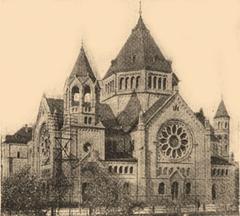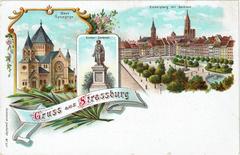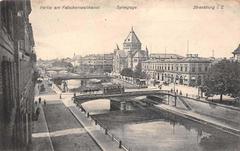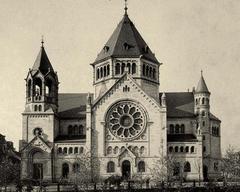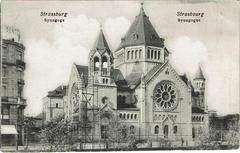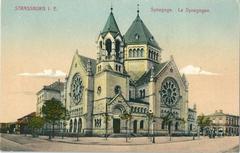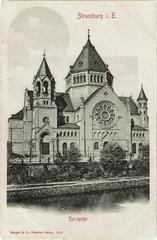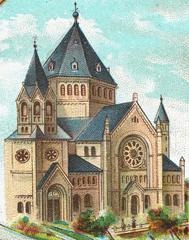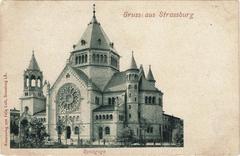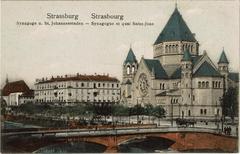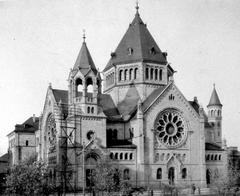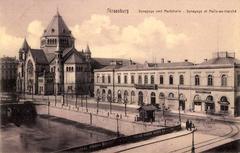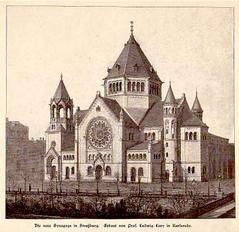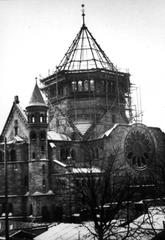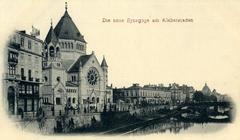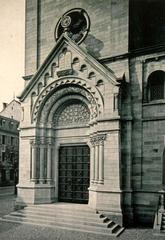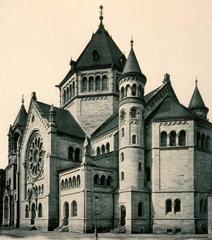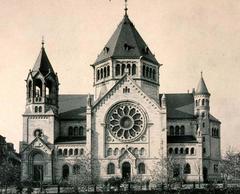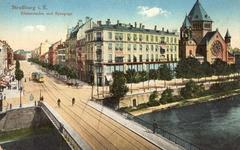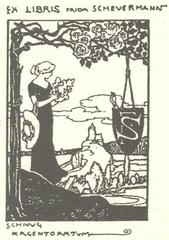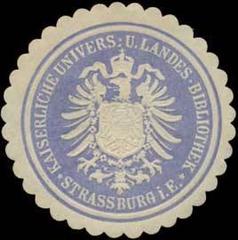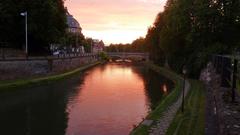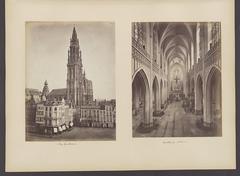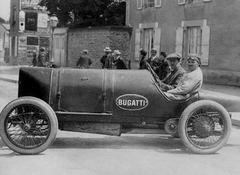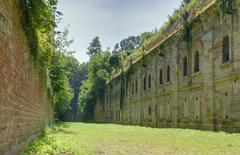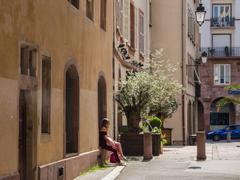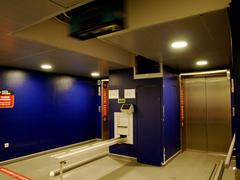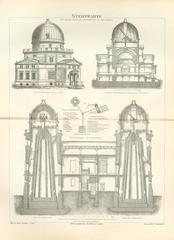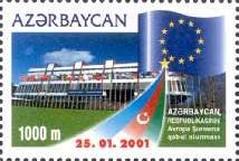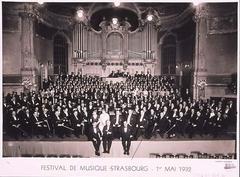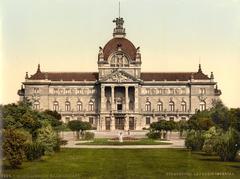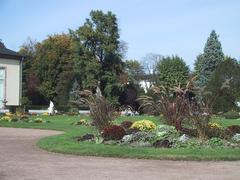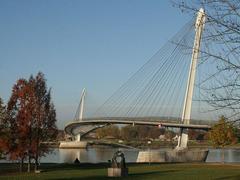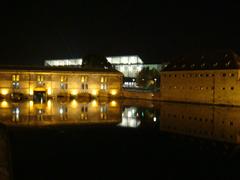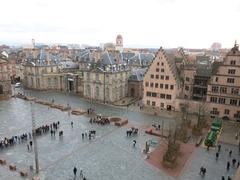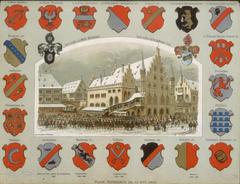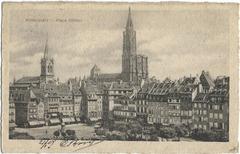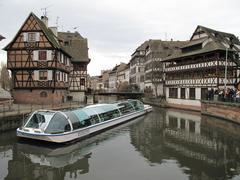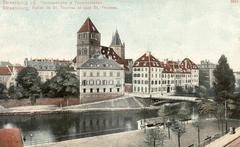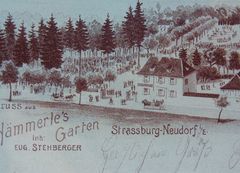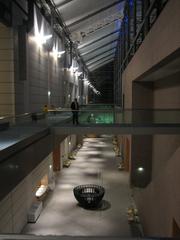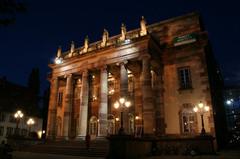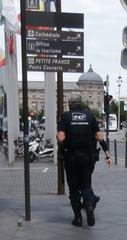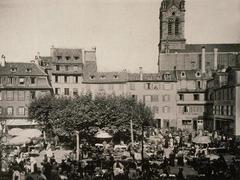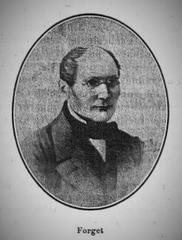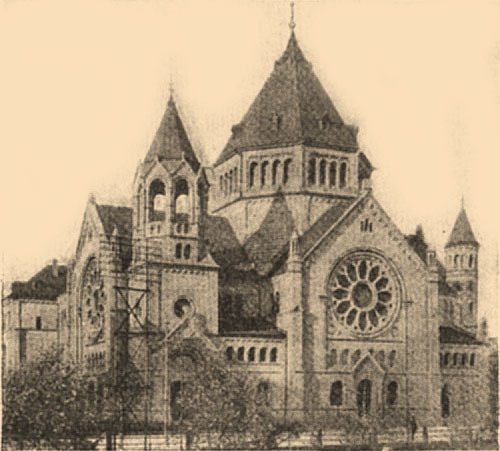
Synagogue du Quai Kléber: Visiting Hours, Tickets, and Strasbourg Historical Sites Guide
Date: 15/06/2025
Introduction
Once a crowning monument of Jewish heritage in Strasbourg, the Synagogue du Quai Kléber stood as a beacon of architectural sophistication and community pride in the Alsace region. Erected in the late 19th century under German administration and designed by Ludwig Levy, this neo-Romanesque marvel was among the largest synagogues in Europe, reflecting both the aspirations and integration of Strasbourg’s Jewish community (Jewish Virtual Library; ArchDaily). Although destroyed during World War II, its memory endures through commemorative sites and educational initiatives woven into the city’s historical landscape.
This guide offers an in-depth look at the synagogue’s history, architectural features, and enduring legacy, while providing practical information for visitors seeking to explore the memorial site and Strasbourg’s wider Jewish heritage. Whether your interest lies in architecture, cultural history, or the stories of resilience that shape Strasbourg, this resource will help ensure a meaningful and respectful visit.
Table of Contents
- Overview and Historical Context
- Architectural Significance
- Community Role and Cultural Integration
- WWII Destruction and Legacy
- Visiting the Memorial Site: Hours, Tickets & Tours
- Accessibility and Travel Tips
- Nearby Attractions & Further Learning
- Frequently Asked Questions (FAQ)
- Sources and Further Reading
1. Overview and Historical Context
Origins and Development
The Synagogue du Quai Kléber was conceived during a period of Jewish emancipation and integration. Following the annexation of Alsace-Lorraine by the German Empire in 1871, Strasbourg’s Jewish population expanded rapidly. The community soon outgrew its old synagogue on Rue des Juifs, prompting the construction of a new, grand synagogue at Quai Kléber (Strasbourg.eu). The foundation stone was laid in 1895, and the synagogue was inaugurated in 1898, symbolizing the community’s growing presence and the city’s evolving identity.
Urban Context
Strategically situated at the intersection of Quai Kléber and Rue du Marais-Vert, near Place Kléber and the old railway station, the synagogue occupied a prominent position in Strasbourg’s Neustadt district. This setting echoed the city’s urban expansion under German rule, with the synagogue’s monumental form harmonizing with the grand boulevards and public buildings of the era (Wikipedia FR; Visit Alsace).
2. Architectural Significance
Style and Influences
Ludwig Levy’s design for the synagogue was a masterwork of Romanesque Revival, drawing inspiration from the imperial cathedrals of the Rhine such as Mainz, Worms, and Speyer. This style was chosen to emphasize both Jewish integration with local traditions and a distinct communal identity (Wikipedia EN; Carrie Anne Brownian; Judaisme Alsalor).
Exterior Features
- Materials: The façade was constructed from pink and grey Vosges sandstone, asserting a regional identity and permanence (Carrie Anne Brownian).
- Massing: The central octagonal tower, rising 54 meters, dominated the skyline. Flanked by smaller turrets and steeply pitched roofs, the silhouette echoed both synagogal and cathedral architecture (Judaisme Alsalor).
- Façade: The main entrance featured a grand portal and rose window, framed by round-arched arcades and subtle Jewish motifs such as Stars of David (Wikipedia FR).
Interior Layout
- Capacity: Accommodated 1,639 worshippers—825 men, 654 women, 40 choristers, and 100 in the oratory (Wikipedia FR; Judaisme Alsalor).
- Sanctuary: The nave was illuminated by stained-glass windows and featured a centrally located bimah. The monumental ark (Aron Kodesh) was crafted from fine wood and stone.
- Organ: A grand organ by E. A. Roethinger, with 62 stops, made the synagogue notable for its musical tradition (Carrie Anne Brownian).
- Stained Glass: Windows designed by Alexander Linnemann depicted symbolic and geometric motifs, bathing the interior in colored light.
Community Spaces
The synagogue complex included administrative offices, clergy apartments, and meeting rooms, serving as a hub for religious, social, and educational activities (Judaisme Alsalor).
3. Community Role and Cultural Integration
From its inauguration, the Synagogue du Quai Kléber served as the spiritual and communal heart of Strasbourg’s Jewish population—hosting daily prayers, religious festivals, and community events. It was also the seat of the Consistoire Israélite du Bas-Rhin and the chief rabbi (Musée Alsacien). By 1936, Strasbourg had one of France’s largest Jewish populations outside Paris.
The building’s architectural grandeur and prominent urban placement signaled Jewish integration into both local and national civic life, while the use of Romanesque forms referenced a shared regional heritage (Wikipedia EN).
4. WWII Destruction and Legacy
The synagogue’s fate changed tragically during the Nazi occupation. In September 1939, as war loomed, Jewish residents were evacuated. On September 30, 1940, the synagogue was set ablaze by the Hitler Youth and subsequently demolished by Nazi authorities (Visit Alsace). The loss marked a profound rupture in Strasbourg’s Jewish life, but the memory of the synagogue endures through commemorative plaques, archival photographs, and educational initiatives.
Today, a memorial square and plaque mark the site, with the Allée des Justes parmi les nations inaugurated in 2012 as a testament to Holocaust victims and the city’s ongoing commitment to remembrance (Visit Alsace).
5. Visiting the Memorial Site: Hours, Tickets & Tours
Location and Access
- Address: Quai Kléber, near Place Kléber, Strasbourg
- Site: Outdoor memorial square with plaque and commemorative signage
Visiting Hours
- Open: 24 hours a day, 7 days a week
- Admission: Free of charge
Accessibility
- Mobility: The memorial is wheelchair accessible, located on flat, paved terrain.
- Public Transport: Easily reached by tram (lines A and D, stop: Homme de Fer) or on foot from the central train station.
Tours and Audio Guides
- Jewish Heritage Circuit: The site is a key stop on Strasbourg’s Jewish heritage walking circuit, which can be explored independently or as part of a group (Visiter Strasbourg).
- Audio Guide: Free digital audio guides and interactive maps are available via the Izi Travel app, in several languages.
- Guided Tours: Group tours can be arranged through the Office de Tourisme or local Jewish heritage organizations. These often include other major sites such as the Synagogue de la Paix and the medieval mikveh (visitstrasbourg.fr).
Visitor Etiquette
- The memorial is a solemn site; visitors are asked to behave respectfully, maintain a quiet demeanor, and dress modestly. Photography is permitted if done discreetly.
6. Accessibility and Travel Tips
- Plan Ahead: Download the Izi Travel app and review the Jewish heritage circuit before your visit.
- Facilities: While the memorial itself has no amenities, the adjacent Place Kléber offers cafes, shops, and public restrooms.
- Tourist Information: The Office de Tourisme at 17 Place de la Cathédrale provides maps and additional guidance.
7. Nearby Attractions & Further Learning
- Place Kléber: Central square with vibrant shops and restaurants.
- Rue des Juifs (Old Jewish Quarter): Remnants of medieval Jewish life and the ancient mikveh.
- Strasbourg Cathedral: Gothic masterpiece with Jewish historical references.
- Synagogue de la Paix: Main synagogue since 1954, open for group visits by arrangement (visitstrasbourg.fr).
- Musée Alsacien & Musée Historique: Museums with collections highlighting Jewish life and local history (Musée Alsacien).
8. Frequently Asked Questions (FAQ)
Q: Can I visit the original Synagogue du Quai Kléber building?
A: No, the original building was destroyed in 1940, but the memorial site is open and accessible to the public.
Q: Is there an entrance fee?
A: No, visiting the memorial is free.
Q: Are guided tours available?
A: Guided tours can be arranged through the Office de Tourisme or local Jewish heritage organizations; audio guides are available for self-guided visits.
Q: Is the memorial site accessible for visitors with disabilities?
A: Yes, the area is wheelchair accessible.
Q: What other Jewish heritage sites are nearby?
A: The Old Jewish Quarter, Synagogue de la Paix, and Strasbourg Cathedral are all within walking distance.
9. Sources and Further Reading
- Jewish Virtual Library
- ArchDaily
- Visit Alsace
- Visiter Strasbourg
- Jewish Heritage Europe
- Judaisme Alsalor
- Carrie Anne Brownian
- Wikipedia FR
- Wikipedia EN
- Musée Alsacien
Conclusion
The story of the Synagogue du Quai Kléber encapsulates the triumphs and tragedies of Strasbourg’s Jewish community. While the physical structure no longer stands, its memory is kept alive through dedicated memorials, archival records, digital resources, and ongoing educational efforts. By visiting the site and exploring the wider Jewish heritage circuit, travelers can pay tribute to a vibrant culture and gain deeper appreciation for the city’s layered history.
For a richer experience, plan your visit using the Izi Travel app, participate in heritage tours, and engage with the city’s museums and educational platforms. By honoring the memory of the Synagogue du Quai Kléber, you contribute to the ongoing recognition and remembrance of Strasbourg’s diverse heritage.
